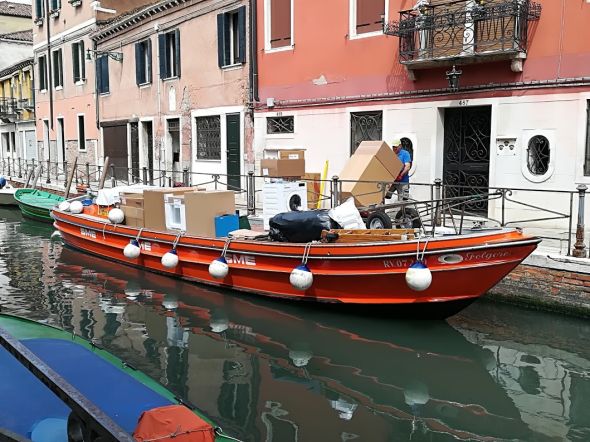
As you know by now, what looks to me like a random person on the vaporetto/street/high seas often carries a cargo of memories for Lino. I get to hear them all, not in any order whatsoever. He seems to review the person’s biography from his mind horizontally.
A few mornings ago we got some seats on the #1 going up the Grand Canal. So far, so surprisingly pleasant. “You see that man over there?” Lino asks.
“The one with the hat?” He was pretty unremarkable, sitting by himself. No hint that he could ever have bubbled like submerged lava with ill-will toward his fellow man. Toward the fellow man sitting right beside me.
The year was sometime between 1965 and the Seventies, and the rio delle Torreselle — the canal behind the Guggenheim Collection — was still home to eleven gondolas. (Now there are two.) Naturally, where there are gondolas, there are gondoliers; Lino, who lived on a very near side-street, would hear them talking in the evening as they came home after work, putting the boats away for the night. The canal was also where Lino kept his little wooden topetta, invisible in this view but up at the end of the row of boats on the left. Idyllic. I’m joking. The story involves gondoliers.

The man on the vaporetto (nickname beginning with “T”) was one of those gondoliers, and tied up his gondola just opposite Lino’s little boat. One day T was seized with the conviction that Lino’s boat was presenting a clear and present danger to the health and well-being of his gondola. Or potential danger. The fact that both were the nearest to the 90-degree curve of the canal might have fomented this notion. But Lino’s boat was about half the size of his, so I suppose if anyone were to be annoyed by its neighbors, it ought to have been the topetta. In any case, NOTHING HAD EVER HAPPENED.
“So he made a formal complaint,” Lino told me. “One day these papers arrive, I have to go to court. He’s claiming one million lire in damage to his boat. I said ‘I don’t even know what a million lire are.’ (Note: It would have been $618 in today’s money, but back then it was way more than a month’s salary.) My lawyer friend saw me looking glum and I told him about all this, and he said ‘Give me all the papers, I’ll take care of it.'”
So a few days later the court sent a surveyor to measure the combatants (the boats, I mean, not the men). “The surveyor is working away,” Lino went on, “and I was saying to T, ‘They’re just boats made of wood! Don’t you have any bigger problems than this? You’ve got your old mother at home to look after…’ And the surveyor is listening as he’s writing his notes. And he turns to me and says, ‘Don’t worry, it’ll be fine.'”
The case was dismissed, and T had to pay the costs. “Then my lawyer friend said, ‘Now we’re going to go ahead and sue for moral damages.’ And I said ‘No, for the love of God, just let it go.'”
That would be enough to remember, but there’s more in the album. “He had a sister, she was unbelievably beautiful. I had such a crush on her when I was 15, I would just tremble when I saw her. I’d stand beneath her window hoping to get a glimpse of her. I never said a word to her, ever… His father was a gondolier too. A big strong man (‘grande, grosso…’). Finished third in the Regata Storica, or maybe it was fourth, I can’t remember the year. I’ve got some papers about it at home somewhere.”
So everyone lived happily ever after? I guess so, in their Venetian way. Lino went on with his life, and when T retired he took his precious gondola someplace and sawed it up into pieces. “He could have sold it, but he had all the money he needed anyway, he owned houses, he wasn’t married. But no, he just went and cut it all up. That’s a normal person?”
